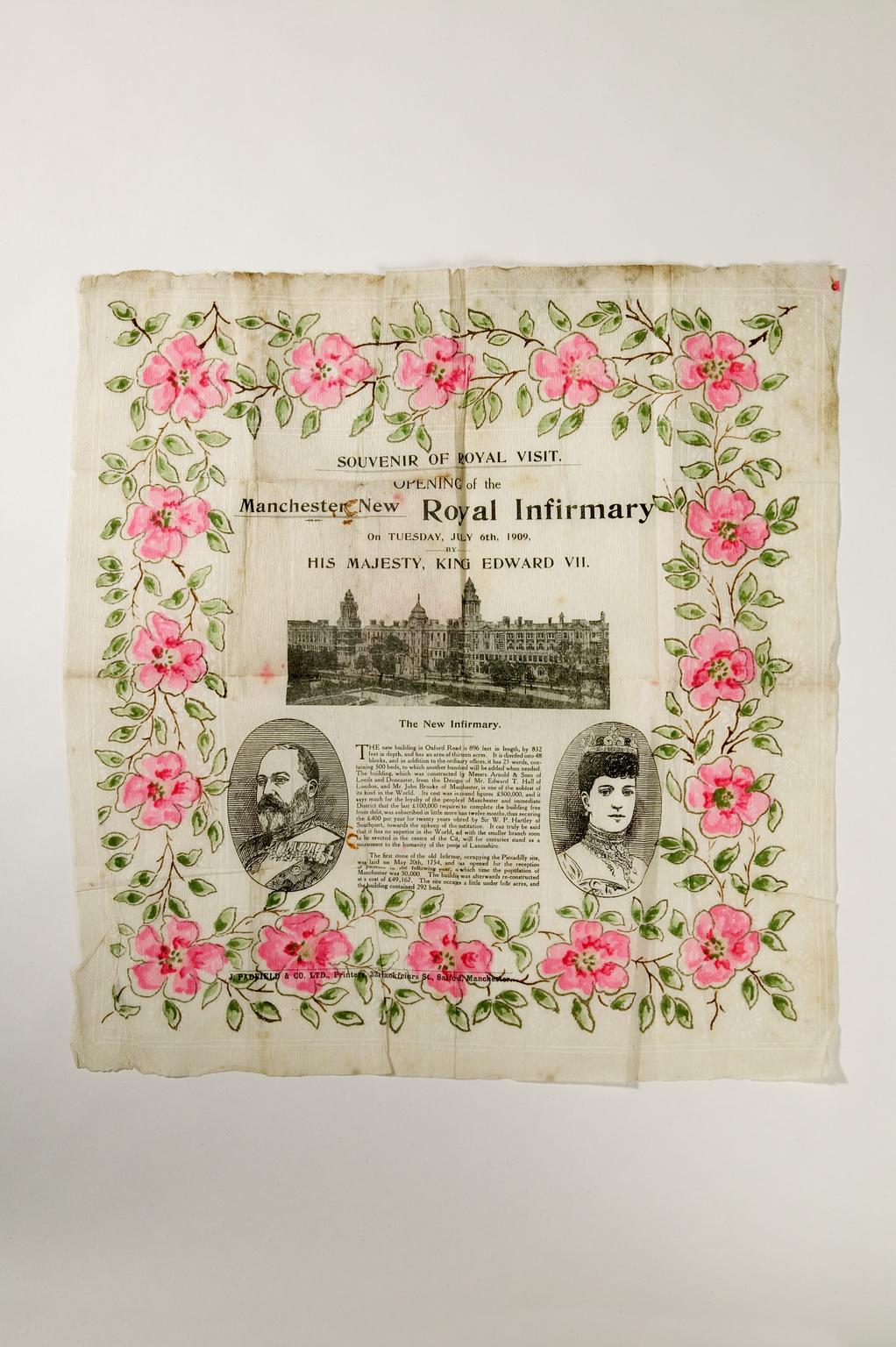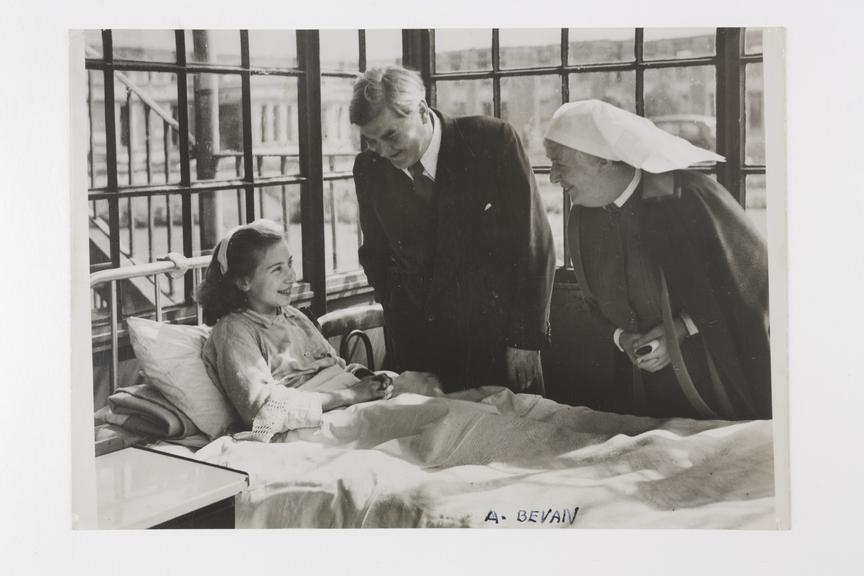The Science and Industry Museum will soon be welcoming the award given to NHS England in recognition of the public service and dedication of its staff and volunteers since its founding in 1948.
The George Cross is the highest award in the UK given for acts of the greatest heroism, and was granted to the NHS in recognition of the many years of public service given by NHS staff and volunteers since 1948 and the ‘courage, compassion and dedication’ of NHS staff and volunteers during the pandemic. Queen Elizabeth II awarded the George Cross to the NHS in July 2021.
Manchester played a key part in the foundation of the NHS and has a long history of public health in action before the institution was established. As the world’s first industrial city, health has long been a concern in Manchester. Overcrowding, poor sanitation and industrial diseases became rife in the city as factories and worker housing were built. Manchester’s first hospital was established in 1752.
Before the NHS, hospitals were established by civic leaders on a volunteer basis and set up as charities by subscribers who gave regular funds. The Manchester Royal Infirmary was originally located at the centre of Piccadilly Gardens and expanded to include public baths, an outpatient department and an asylum. The hospital moved to its present Oxford Road site, officially opened by King Edward VII and Queen Alexandra, in 1909.

Science Museum Group Collection © The Board of Trustees of the Science Museum

Science Museum Group Collection © The Board of Trustees of the Science Museum
Over 100 years before the COVID-19 pandemic hit the city, Mancunians were dealing with another deadly illness when the 1918–1920 flu pandemic struck. The disease spread as troops came home from serving in Europe in the First Word War, and it soon moved around the world. It primarily affected young adults aged between 20 and 40, and symptoms were rather gruesome—alongside typical flu symptoms of aches, sore throats and headaches, those infected also coughed up blood, with some people effectively drowning from the frothy blood that formed in their lungs.
Between 1918–1920, the flu pandemic is thought to have killed up to 100 million people around the world. Dr James Niven was Manchester’s Medical Officer for Health when the pandemic struck, and he issued a leaflet across the city to describe how to prevent the spread. Much of what he wrote is similar to measures introduced for the COVID-19 pandemic:
‘Crowded rooms should be avoided, and the sick should be isolated at once, in the household as well as in the factory and workshop. In cases of illness at work and inability to walk home, a telephone message should be sent to “City 8680 Medical” for an ambulance.
Whenever possible, the sufferer should have a separate room. The room should be ventilated by an open window, so as to lessen the risk to others, but as the sick are liable to develop pneumonia, they must be kept warm by a sufficiency of bedclothes. When there is fog, the window should be closed and a fire kept in the room. Sick persons should not return to work except under medical advice.’ (source)
Dr Niven worked in Manchester for 28 years and successfully implemented measures to improve public health, including slum clearances and installation of flushing toilets. In 1923 he published Observations on the History of Public Health Effort in Manchester, where he stated that the most important measures taken in Manchester to address health has been the removal of organic filth, the control of infectious disease and the reduction of poverty.2 Dr Niven’s work demonstrates the importance of a public health approach in keeping a city healthy, and his ideas were considered ahead of his time.
As Manchester continued to grow to be a research centre for medical advancement, new treatments were pioneered in the hospitals and specialist centres that were being established across the city in the early 20th century. In the 1930s, radium had become one of the most expensive materials in the world because of its rarity and its usefulness—radium was something that could be used to treat cancer. Manchester’s Holt brewing family promised £4,000 as an initial donation to set up the Manchester and District Radium Fund, and in 1932, the Holt Radium Institute joined with the Christie Hospital at their site in Withington.
The Christie, today part of the NHS, became famous for its targeted use and research into radium. The scientists asked questions about how much radium, and in what size doses, should be used to treat cancer. They devised what became known as the ‘Manchester method’, the first international standard for measuring and determining the most effective dose of radium therapy. The Christie NHS Foundation Trust is now one of the largest specialist cancer hospitals in Europe.

Science Museum Group Collection © The Board of Trustees of the Science Museum
Possibly the most pivotal health event that happened in Manchester was the opening of the very first NHS hospital at Davyhulme Park Hospital, now known as Trafford General Hospital. On 5 July 1948, Health Minister Anuerin Bevin visited the hospital to signify it was the first one in the UK to be handed over to the new NHS. Mr Bevin was escorted around the hospital with the Matron, Miss Dolan, and was then introduced to 13-year-old Sylvia Beckingham, the first NHS patient.
The NHS was founded after the Second World War, in a time of social and political upheaval, and brought free access to healthcare for the first time. To find out more about the founding of the NHS, including memories of the first days of the service, the University of Manchester’s Voices of our NHS project has resources and oral histories to hear stories from people who were there.

Daily Herald Archive/Science Museum Group/SSPL © Mirrorpix
Another huge medical first that happened in Greater Manchester was the birth of the world’s first IVF baby in the Royal Oldham Hospital. Also known as a ‘test-tube baby’, Louise Brown was born at 23.47 on 25 July 1978 weighing 5lb 12oz. Louise’s birth was the result of many years of research and failed attempts by gynaecologist Patrick Steptoe and Nobel Prize-winning physiologist Robert Edwards. IVF has now been used to help millions of families have children across the world. The Science Museum is home to the glass incubator where the embryos were left to develop before being implanted into the womb. IVF is now available on the NHS as well as privately for people wanting help to conceive, and it all started from a glass jar in Oldham.
As well as pioneering treatments and new research methods in medicine, Manchester also has needed to respond to urgent health risks. COVID-19 saw the world reacting to the new threat it posed and scientists set to work on vaccine development, improving masks to prevent the spread, and providing safe spaces for treatment. In Manchester, the Nightingale Hospital was established in the Manchester Central convention centre, a former railway station, in just 13 days. This temporary hospital was set up to care for people recovering from COVID, complete with hospital beds, infection control measures, centralised oxygen provision, and facilities for staff. Many organisations came together to build the hospital, including the Army, Fire Service, NHS, Network Rail and the Police. Incredibly, the Nightingale Hospital in Manchester was only needed for a small number of cases, but the work to keep the city safe in a pandemic was no less impressive.
Across Greater Manchester there is pioneering research and new medical techniques being trialled every day, in our academic institutions and hospitals. Part of our job at the museum is to identify these advancements to ensure we can collect the objects and stories which are changing the world today.
You can see the George Cross medal awarded to NHS England at the Science and Industry Museum from 9 February 2024.